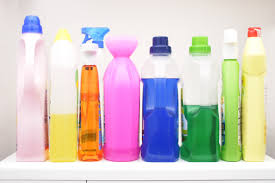Cleaning agent information by Chemical Man
Cleaning agents are substances (usually liquids, powders, sprays, or granules) used to remove dirt, including dust, stains, bad smells, and clutter on surfaces. Purposes of cleaning agents include health, beauty, removing offensive odor, and avoiding the spread of dirt and contaminants to oneself and others. Some cleaning agents can kill bacteria, e.g. on door handles, worktops and other metallic surfaces, and clean at the same time. Others, called degreasers, contain organic solvents to help dissolve oils and fats.
Acidic
Acidic cleaning agents are mainly used for removal of inorganic deposits like scaling. The active ingredients are normally strong mineral acids and chelants. Often, surfactants and corrosion inhibitors are added to the acid.
Hydrochloric acid is a common mineral acid typically used for concrete. Vinegar can also be used to clean hard surfaces and remove calcium deposits. Sulphuric acid is used in acidic drain cleaners to unblock clogged pipes by dissolving greases, proteins, and even carbohydrate-containing substances such as toilet tissue.
Alkaline
Alkaline cleaning agents contain strong bases like sodium hydroxide or potassium hydroxide. Bleach (pH 12) and ammonia (pH 11) are common alkaline cleaning agents. Often, dispersants, to prevent redeposition of dissolved dirt, and chelants, to attack rust, are added to the alkaline agent.Alkaline cleaners can dissolve fats (including grease), oils, and protein-based substances.
Neutral
Neutral washing agents are pH-neutral and based on non-ionic surfactants that disperse different types
Degreaser
Cleaning agents specially made for removal of grease are called degreasers. These may be solvent-based or solvent-containing and metamorphicSome cleaners contain water-soluble organic solvents like glycol ethers and fatty alcohols, which ease the removal of oil, fat and paint. Disinfectant additives include quaternary ammonium compounds, phenol derivatives, terpene alcohols (pine oil), aldehydes, and aldehyde-amine condensation products.
All-purpose cleansers are effective with most common kinds of dirt. Their dilute solutions are neutral or weakly alkaline, and are safe for use on most surfaces.
Scouring cleaners
Dishwashing agents
Manual dishwashing detergents (MDDs)
Automatic dishwashing detergents (ADDs)
Floor cleaners
Carpet cleaners
Toilet bowl cleaners
Toilet hygiene and deodorant products
Drain cleaners
Metal cleaners
Metal cleaners are used for cleaning stainless steel sinks, faucets, metal trim, silverware, etc. These products contain abrasives (e.g., siliceous chalk, diatomaceous earth, alumina) with a particle size < 20 μm. Fatty alcohol or alkylphenol polyglycol ethers with 7-12 ethylene oxide (EO) units are used as surfactants.Stainless steel, nickel, and chromium cleaners contain lactic, citric, or phosphoric acid. A solvent (mineral spirits) may be added.Nonferrous metal cleaners contain ammonia, ammonium soaps (ammonium oleate, stearate) and chelating agents (ammonium citrate, oxalate).Silverware can be freed of silver sulfide tarnish with thiourea, and either hydrochloric or sulfuric acid.
Window cleaners
Automotive cleansers
Building facade cleaners
Cleanser components
Decontaminators
Sequestrants (Builders)
Surfactants
Corrosion Inhibitors
Foam Inhibitors
Enzymes


Leave a comment